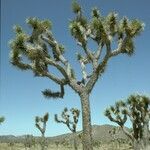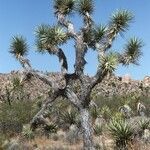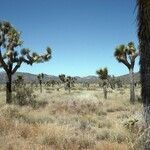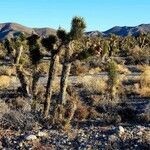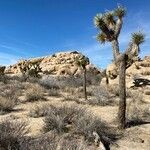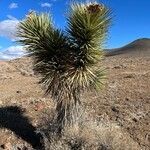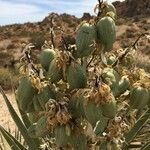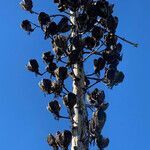Plants usually solitary, erect, arborescent, to 15 m. Stems usually 1, occasionally several–many, simple or usually branched distally; branches 1–3 m. Leaf blade green, 15–35 × 0.7–1.5 cm, rigid, smooth, glabrous, margins nearly entire, minutely denticulate, yellow. Inflorescences erect, paniculate, densely crowded, ca. 1/2 enclosed in rosettes, ellipsoid-ovoid, 3–5.5 × 3–3.8 dm, glabrous. Flowers erect, 4–7 cm; perianth oblong-ellipsoid to globose; tepals barely connate at base, greenish white to cream, lanceolate to oblong, 2.5–7 × 1.1–2.2 cm; filaments 1–1.2 cm; anthers 3–3.2 mm, short-pubescent to papillate; pistil 2–3.5 cm; ovary ovoid, 2.5–3 cm, longer than broad; style ca. 1.6 mm; stigmas distinct. Fruits pendent, capsular, indehiscent, deeply furrowed, ellipsoid, 6–8.5 cm, dry, spongy. Seeds dull black, thin, 8–12 mm diam., smooth.
More
A shrub or small tree. It grows 9-12 m high and spreads 1.5 m wide. The stem branches. The bark is grey or orange-brown. It forms in plates. The leaves are straight and narrow. They have fine teeth along the edge. The flower spikes have greenish flowers. They have an unpleasant smell.
The flower clusters are partly boiled in salt water to remove bitterness, drained and cooked then eaten. The open flower buds are roasted and eaten. The roots are eaten raw, boiled or roasted. Seeds are eaten.
Can be grown by cuttings, divisions or seedlings. Seeds needs soaking.
